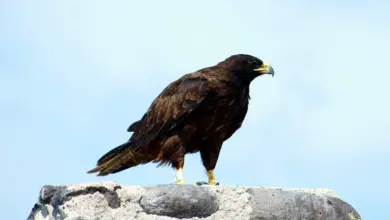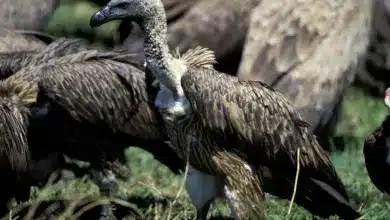Yellow-bellied Flycatchers
The Yellow-bellied Flycatchers (Empidonax flaviventris) are small, migratory birds that are found throughout North and Central America, and some Caribbean islands.
These insect-eating birds are quite common within their vast range that stretches over about 2 million sq. miles (5.3 million sq. km) with an estimated population of about 6.2 million individuals.
Distribution / Habitat
Breeding Territory
They breed from western Canada – from central and northern British Columbia and west central and southern Mackenzie east to Newfoundland, Prince Edward Island and Nova Scotia.
Their breeding range stretches south into northeastern USA – east from northern Minnesota and the Great Lakes region, south into Pennsylvania and central New York. Disjunct populations exist in West Virginia and on Saint Pierre Island in the northwestern Atlantic Ocean near Canada.
Their breeding habitat is smossy muskeg forests and peatlands.
The Yellow-bellied Flycatchers remain in their breeding territory only for about 70 days or up to 3 months. Soon after having raised their young, they migrate south to southern Mexico and Central America for the winter.
Winter Territory
They overwinter in southeastern and southwestern Mexico – specifically along the Caribbean slope from southern Tamaulipas; and on the Pacific slope from Oaxaca south through Belize, Costa Rica, El Salvador, Guatemala, Honduras, and Nicaragua to western Panama.
They can be found in temperate, tropical, and subtropical forests, in shade-grown coffee plantations and in wetland areas, such as rivers, marshes, swamps, and peatlands.
Vagrants
Vagrants have been reported in Cuba, Greenland, and Jamaica.
Description
Size
- Small flycatcher, with a length of 5-1 – 5.9 inches (13 – 15 cm) and a wingspan of 7.1 – 7.9 inches (18 – 20 cm)
- Weight: 0.3 – 0.6 oz (9 – 16 g)
Plumage Details / Adults
- Upper Plumage: ranges in color from olive-green to brownish-olive; darker on the wings and tail
- Two white wing bars
- Underparts: yellowish underparts with an olive-green wash on the chest and a pale-yellow belly
- Breeding birds are more yellow below than wintering birds.
Other Physical Details
- Small flycatcher with a relatively large, rounded head
- Yellow eye rings
- Small, two-toned bill: Upper beak is black. The lower beak is yellow-orange/pinkish.
- Short tail
Gender ID
Males and females look alike.
Juvenile Description
Resemble the adults, except their wing bars are buffy (white in adults)
Similar Species
The Yellow-bellied Flycatcher is easily separated from other eastern Empidonax flycatchers by its yellow underparts.
The Pacific-slope Flycatchers (Empidonax difficilis) or the Cordilleran Flycatcher (Empidonax occidentalis) – sometimes referred to as the “Western Flycatchers” have teardrop-shaped eyerings and duller wing feathers, longer tails and shorter primary flight feathers.
The Yellow-bellied Flycatchers are larger than the Least flycatchers, which are also greyer above and whiter below.
The Acadian Flycatchers have longer tails, larger bills, and less yellow on the throat.
The Pewees are larger in size. Their underparts are whiter. Their eye rings are less bold.
Diet / Feeding
Yellow-bellied Flycatchers feed on insects and arthropods (such as spiders, worms, centipedes, etc.). Insects are captured in mid-air or gleaned from foliage.
To a lesser extent, they feed on berries and seeds.
Breeding / Nesting
The typical nesting habitat of the Yellow-bellied Flycatchers is cool, moist conifer or mixed forests, bogs, swamps, or muskegs aka bogland.
Their cup nests are constructed out of moss and lined with rootlets, pine needles or grass stems. They are placed in sphagnum moss on or near the ground, in concealed areas with hanging vegetation.
A clutch consists of 2 to 5 white eggs with light brown spots and small blotches around the rounded end. The hatchlings are without any down and completely dependent on parental care.
Calls / Vocalizations / Sounds
Their flight songs are typically heard at predawn or dusk.
Song: rendered as “pse-k”, “per-WEE”, “chiu”, or a dry “CHE-bek“
Call: rendered as “chu-wee,” ascending in pitch
http://www.xeno-canto.org/embed.php?XC=142360&simple=1
Alternate (Global) Names
Chinese: ????? … Czech: Tyranovec žlutobrichý, tyranovec žlutob?ichý … Danish: Gulbuget Empidonax … Dutch: Berkenfeetiran, Geelbuiktiran … German: Birkenschnäppertyrann, Birkentyrann, Birken-Tyrann … English: Yellow-bellied Flycatcher … Estonian: kuuse-salutikat … Finnish: Kuusisieppari … French: Moucherolle à ventre jaune … Italian: Pigliamosche panciagialla, Pigliamosche ventregiallo … Japanese: kibaramejirohaetori … Norwegian: Gulbukempid … Polish: empidonka zóltobrzucha, empidonka ?ó?tobrzucha … Russian: ??????????? ????????? … Slovak: pamuchár žltobruchý … Spanish: Atrapamoscas Buchiamarillo, Bobito Amarillo, Mosquerito oliva, Mosquerito Vientriamarillo, Mosquero panza amarilla, Mosquero Ventriamarillo, Mosquero Vientre Amarillo, Mosquero Vientre-amarillo, Mosqueta de Vientre Amarillo, Mosquitero Ventriamarillo … Swedish: Gulbukad empid, Gulbukig empid
Tyrant Flycatchers
Overview … Alternate (Global) Names
Description … Calls / Vocalizations
Breeding / Nesting … Diet / Feeding



